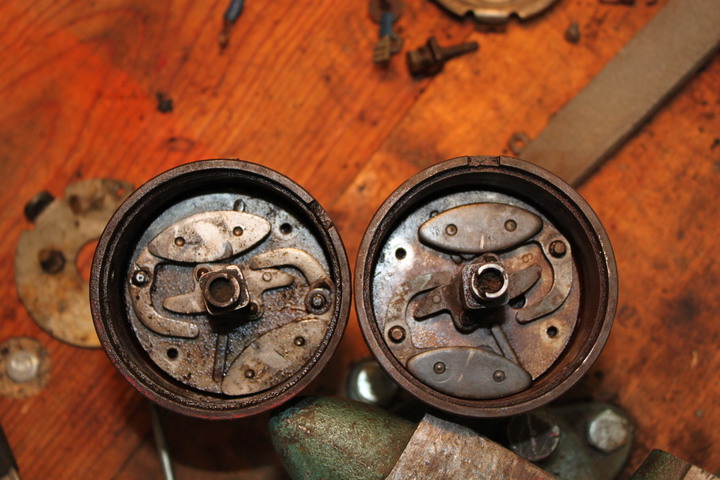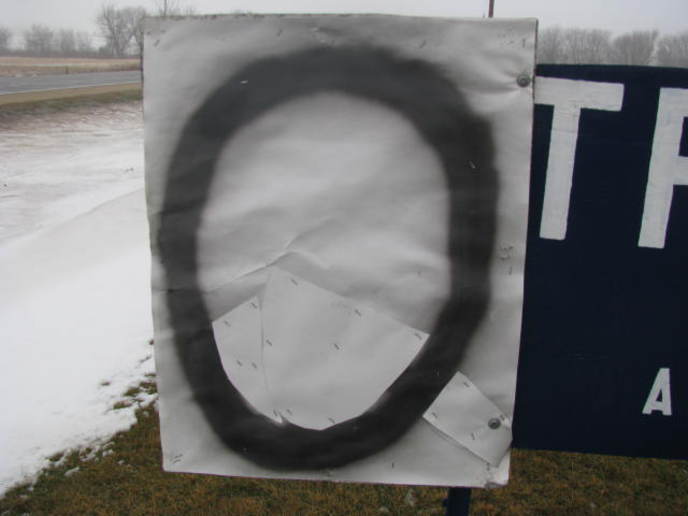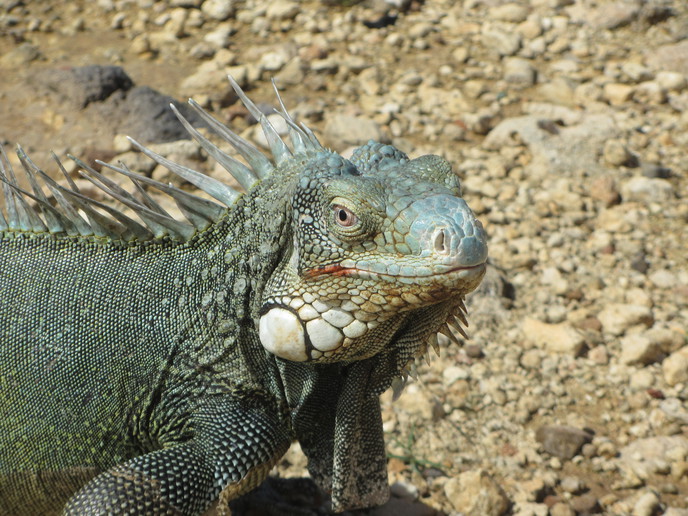You should upgrade or use an alternative browser.
- Thread starter C. Amick
- Start date
Jim Becker
Well-known Member
Each shaft is stamped with the total advance and rotation direction. Part of that mark can be seen in the distributor on the right. You can see an "8" and part of what has to be an "R". This means 8 degree advance and right (CW) rotation. The 8 degree limit implies it is from a gas start Diesel. You can also identify distributors by a code stamped in the mounting flange. The Diesel distributor will probably be stamped either "C" or "H".
The stamping isn't visible on the distributor on the left. It is probably "30L" (flange code "J").
Nebraska Cowman
Well-known Member
the direction so it is the same on either end.
Unless you are talking about with the drive
removed. Confusing?
Jim Becker
Well-known Member
One needs to understand the meaning of clockwise/counterclockwise in order to avoid confusion from the "R" and "L" stamping on each distributor shaft.
/Electrical/Page-36.jpg)
Bob M
Well-known Member
So the unit on the left in the picture - which turns CW as viewed from the distributor cap - is actually considered a "CCW" distributor.
So the previous answers to what each distributor can fit are still correct. It's the semantics of the definition distributor shaft rotation causing the confusion.
Jim Becker
Well-known Member
Except that the "8" means that distributor is correct for a gas start Diesel, not a 9-series gas engine.(quoted from post at 14:42:41 03/08/14)
So the previous answers to what each distributor can fit are still correct.
As already posted the number 8 showing on the right distributor indicates its almost certain to be a gas start diesel distributor.
On a C the shaft from the front of engine driving the distributor turns the same direction as the engine crankshaft. When it goes through the other gear set in the distributor unit the cap end of the distributor turns clockwise when facing the cap or drive end of a complete unit.
<img src = "http://i167.photobucket.com/albums/u125/27Grainfield/IH/help1_zpsb2c2ab51.jpg">
Jim Becker
Well-known Member
Maybe except for the fact that every distributor shaft came from the factory stamped with either an "L" or an "R". If you want to say it backwards, you constantly face the improbable coding of "L" means clockwise and "R" means counterclockwise. I suppose you could insist that your truck came with four tires on top because you always stand on your head when you look at it.(quoted from post at 00:28:04 03/09/14) In answer to the original question, what the factory may or may not have called them is really a moot point.
(quoted from post at 01:55:46 03/09/14)Maybe except for the fact that every distributor shaft came from the factory stamped with either an "L" or an "R". If you want to say it backwards, you constantly face the improbable coding of "L" means clockwise and "R" means counterclockwise. I suppose you could insist that your truck came with four tires on top because you always stand on your head when you look at it.(quoted from post at 00:28:04 03/09/14) In answer to the original question, what the factory may or may not have called them is really a moot point.
Jim, you are missing my point. I don't WANT to be different than the OEM folks, nor argue with you.
The OP didn't see/notice the L or R markings, and asked "which was the correct distributor". (NOT "what do the marks I never saw mean".)
I answered his question, along with the note that they turn CW when viewed from the back of the engine. That is TRUE and not a "diss" of the factory nomenclature, is it???
If someone asked what in which direction the firing order goes, would it be better to say "clockwise, looking at the distributor cap" or "left"?
C parts book and some others has listed CC for the distributor. Others don't say in the parts book. Other IH information lists a C,H, ETC as clockwise or the same as a magneto ID so they would be the same direction from both ends if the distributor was compete with the drive.
Some parts list the distributor as a Unit including the drive end and the distributor without drive end a assembly. Some call the complete thing a assembly.
Going to admit I don't know the correct sure answer. Long as I know what direction they go, don't guess it maters.
Whatever the correct definition its easy for me to remember that the ignition drive or hydraulic pump on the A through 450 gas turns the same direction as the engine crankshaft. Gas start diesels and W9 through 650 gas turn opposite the crankshaft. Then just think about the ignition unit gears reversing that.
Janicholson
Well-known Member
I believe we need to agree that the counter intuitive position taken and embedded at IH when the first markings were put on (whether mag or dist)is used by them and that the markings are as such.
I will continue to indicate CCW or CW as rotation of the rotor in that direction when looking at it.
I believe I have always done so.
IH could have made everything simple by changing the diesel drive direction so it matched the Geas direction but had a different mount so it was incompatible. If I refer to a distributor markings or question I will point out the meaning of the lettering used by IH on the components. Jim's Thinking. Peace and Harmony.
rustred
Well-known Member
before I was picturing it turning ccw. so the advance arms were rubbing on the shaft arms. it makes more sense now I think for it to turn cw.
I am going to open a gas and diesel dist today and satisfy my curiosity. post some pic"s of each also.
yes I know gas do turn cw and diesel ccw.
catch ya later.
Jim Becker
Well-known Member
You are missing my point as well. True, the OP didn't ask about the markings. Whether he had seen them or not, he is/was likely to see them as soon as he pulls a couple more parts out of either unit. He never asked which way the distributors turned either. He just asked which one was correct for his C.(quoted from post at 02:41:07 03/09/14)(quoted from post at 01:55:46 03/09/14)Maybe except for the fact that every distributor shaft came from the factory stamped with either an "L" or an "R". If you want to say it backwards, you constantly face the improbable coding of "L" means clockwise and "R" means counterclockwise. I suppose you could insist that your truck came with four tires on top because you always stand on your head when you look at it.(quoted from post at 00:28:04 03/09/14) In answer to the original question, what the factory may or may not have called them is really a moot point.
Jim, you are missing my point. I don't WANT to be different than the OEM folks, nor argue with you.
The OP didn't see/notice the L or R markings, and asked "which was the correct distributor". (NOT "what do the marks I never saw mean".)
I answered his question, along with the note that they turn CW when viewed from the back of the engine. That is TRUE and not a "diss" of the factory nomenclature, is it???
If someone asked what in which direction the firing order goes, would it be better to say "clockwise, looking at the distributor cap" or "left"?
Once you introduced the unasked and potentially confusing designations of CW and CCW, it seemed appropriate to anticipate the question that was likely to be generated when he (or some later reader) notices an "L" stamped into a "clockwise" distributor or an "R" stamped into a "counterclockwise" distributor.
He didn't ask about firing order either. If he had and I had answered. I would have said clockwise. But somebody plugging wires into a cap isn't going to see the "L" and "R" stampings anyway. If someone is digging deep enough into a distributor to be able to see those marks, they need to know what they mean. This is especially true in a case like this where he has 2 VERY different distributors and is trying to fish enough good parts out of both of them to put together one functioning distributer.
I never thought it was inappropriate to anticipate a likely follow-up question and respond with an answer so the OP has a chance to see the added information when he looks at the responses. Maybe I am wrong on that point as well.
Parts just won't line up with the holes.
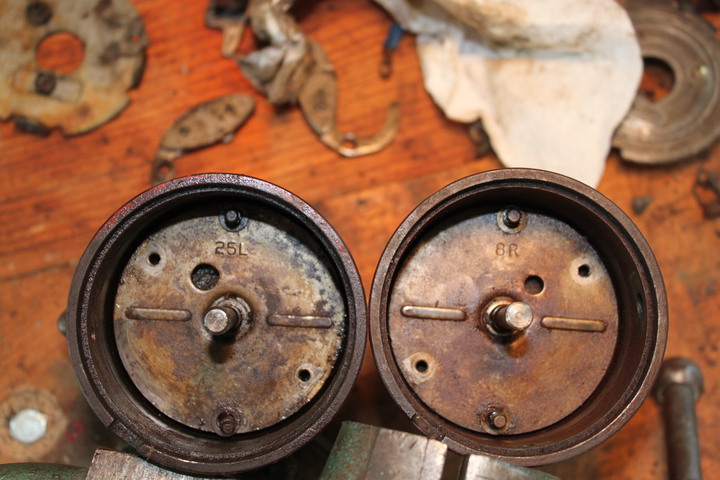
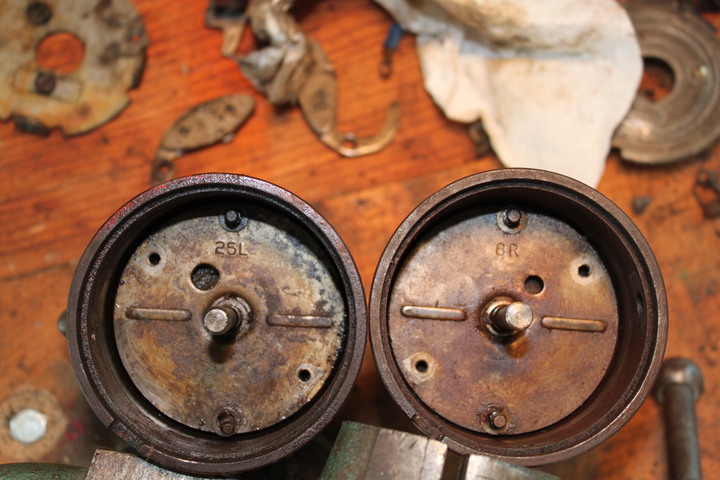
Jim Becker
Well-known Member
By the way, the number on the shaft corresponds to crankshaft degrees. Movement at the distributor is half as much.
Bushing material lets the grease soak through, just enough grease is put in until it exits the hole on the other side of the grease hole.(quoted from post at 07:15:54 03/11/14) Thanks for the sketch. Do you know the purpose for the plug that is the side of the the distributor casting? You remove it with a screwdriver. I used to think it was a place to install a grease fitting to lubricate the distributor shaft. I realize now that the hole doesn't go all the way through the brass sleeve that the distributor shaft runs in, so no grease can reach the shaft unless you were to drill a hole in the side of the sleeve.
Distributor with L-25 may be from a 400 or 450 tractor engine.
Look on the distributor base where the clamps go. Stamped in you may find the letter N followed by a letter for month. Jan.=A, ETC. Next a number for the year built. Maybe a 4 to 8. 1954 to 58. Next would be a serial number. Or if the unit has a different first letter than N post the info.
What parts do you need? Looks like the weight post is loose on the gas.
Yes I have drilled the # eights to use on a gas before when I needed a different advance and also a good rotor shaft or also a housing with serviceable bushing. That way you can make the hole to the max advanced wanted. Placement of the hole is critical on placing the weights on the right swing arc to the cam. Will also change the advance rate from original with little changes.
Think I didn't say the first letter on the base can ID the original advance and intended use. May not be what's found now though. First letter was called the distributor symbol.
Interestingly the list I have that id's a N symbol gasoline says its a CW distributor. Doesn't specify the direction viewing from.
400,450 parts book doesn't specify the rotation direction. Older parts books for like A or C say CCW for a distributor turning the same direction as a 400 gas.
Jim Becker
Well-known Member
H = 8R and N = 25L agree with original codes/markings.(quoted from post at 08:56:23 03/15/14)
HC5-768557 for the 8R
NJ5-832495 for the 25L
Edit: After posting this, I see that D Slater already replied with the same (modern view, it was on the next page).
Similar threads
- Replies
- 2
- Views
- 183
- Replies
- 5
- Views
- 178
- Replies
- 3
- Views
- 268
We sell tractor parts! We have the parts you need to repair your tractor - the right parts. Our low prices and years of research make us your best choice when you need parts. Shop Online Today.
Copyright © 1997-2024 Yesterday's Tractor Co.
All Rights Reserved. Reproduction of any part of this website, including design and content, without written permission is strictly prohibited. Trade Marks and Trade Names contained and used in this Website are those of others, and are used in this Website in a descriptive sense to refer to the products of others. Use of this Web site constitutes acceptance of our User Agreement and Privacy Policy TRADEMARK DISCLAIMER: Tradenames and Trademarks referred to within Yesterday's Tractor Co. products and within the Yesterday's Tractor Co. websites are the property of their respective trademark holders. None of these trademark holders are affiliated with Yesterday's Tractor Co., our products, or our website nor are we sponsored by them. John Deere and its logos are the registered trademarks of the John Deere Corporation. Agco, Agco Allis, White, Massey Ferguson and their logos are the registered trademarks of AGCO Corporation. Case, Case-IH, Farmall, International Harvester, New Holland and their logos are registered trademarks of CNH Global N.V.
Yesterday's Tractors - Antique Tractor Headquarters
Website Accessibility Policy


